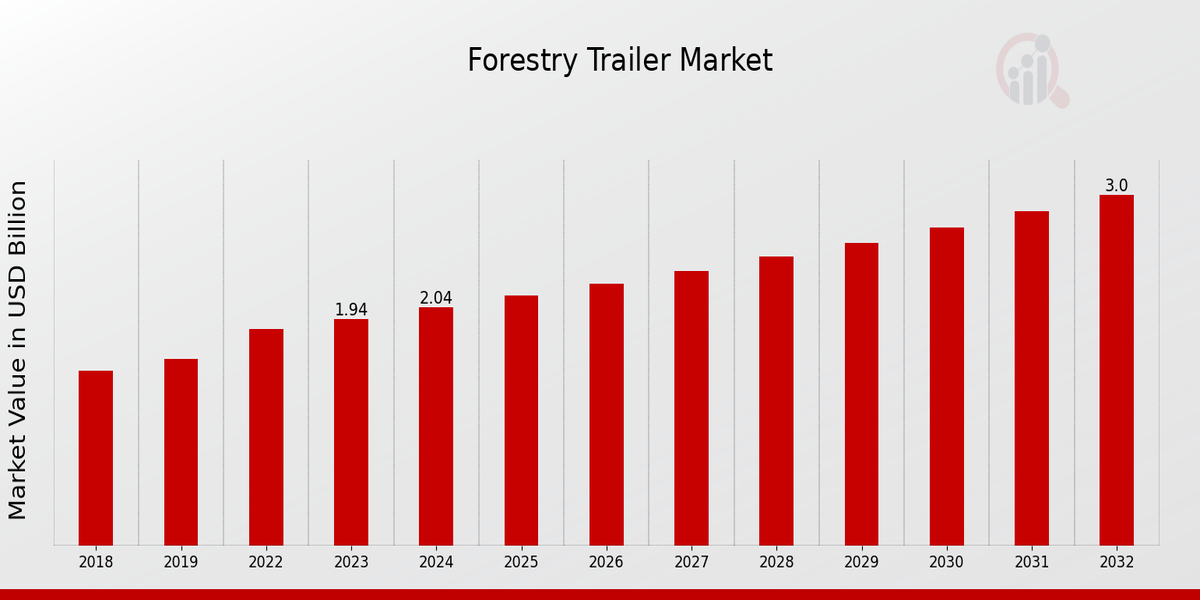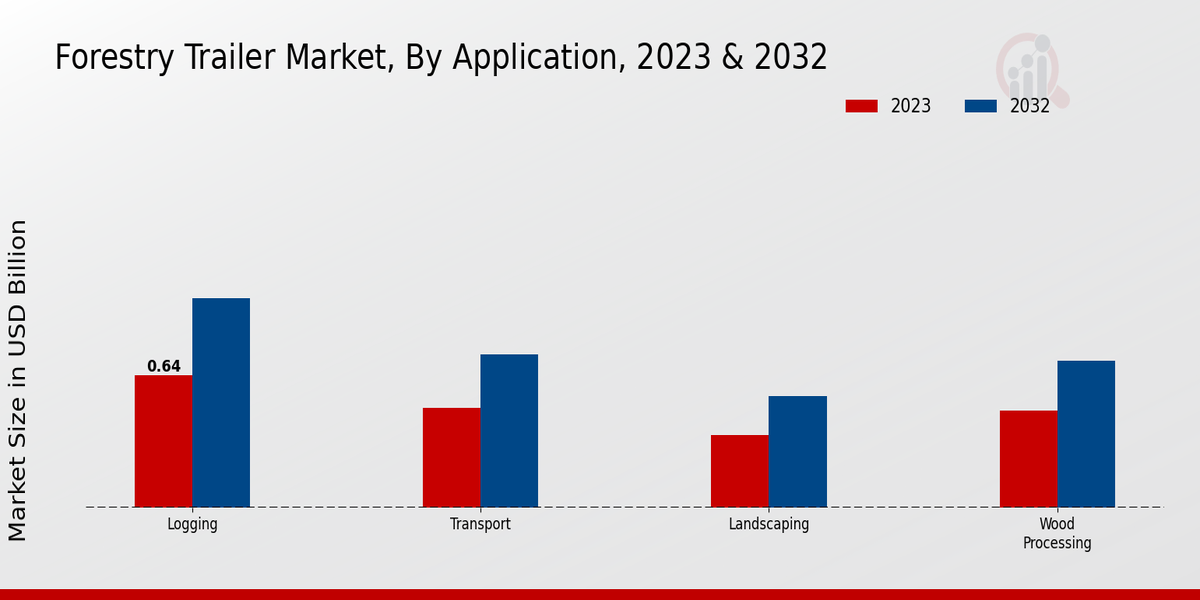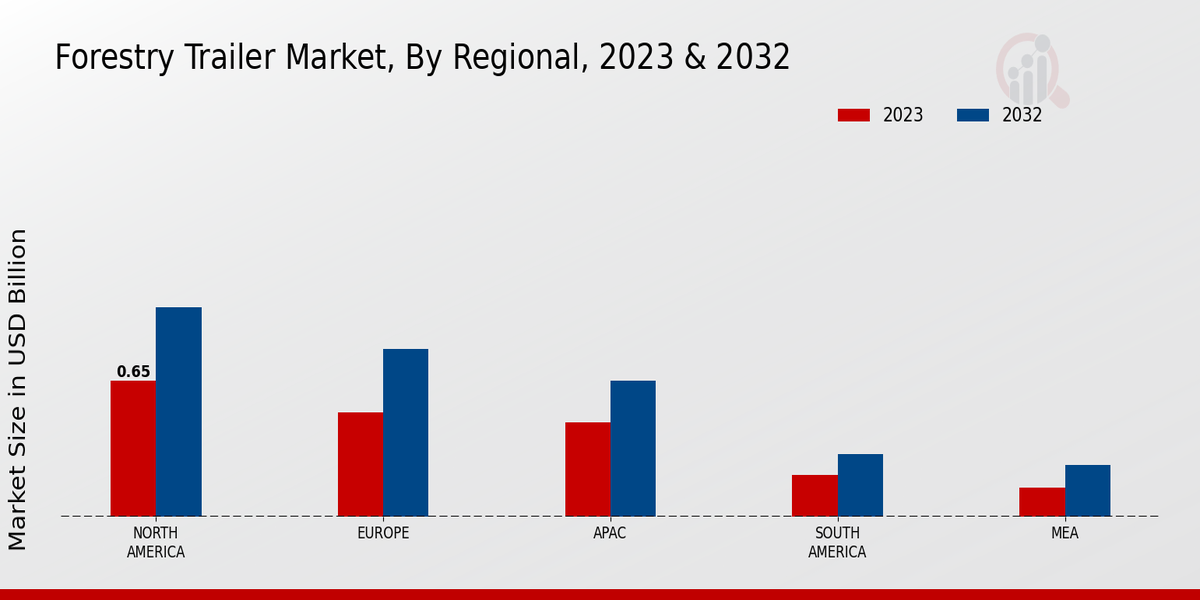Forestry Trailer Market Overview
As per MRFR analysis, the Forestry Trailer Market Size was estimated at 2.14 (USD Billion) in 2024. The Forestry Trailer Market Industry is expected to grow from 2.24 (USD Billion) in 2025 to 3.47 (USD Billion) till 2034, at a CAGR (growth rate) is expected to be around 4.95% during the forecast period (2025 - 2034).
Key Forestry Trailer Market Trends Highlighted
The forestry trailer market is experiencing significant growth driven by the increasing demand for efficient logging and timber transportation solutions. One of the key market drivers is the rise in construction activities, which fuels the need for raw materials like timber. Additionally, advancements in trailer technology have made these vehicles more durable and versatile, catering to diverse forestry applications. Environmental regulations are also propelling the market as companies seek more sustainable and eco-friendly methods for timber harvesting and transport. Various opportunities can be explored within this market. The integration of smart technologies into forestry trailers can enhance operational efficiency and improve safety measures.
By adopting telematics and GPS systems, companies can optimize routes, monitor loads, and ensure compliance with regulations. Emerging markets also present a chance for growth as developing countries increase investment in infrastructure and forestry management. Collaborations between manufacturers and forestry companies can lead to tailored solutions that meet specific needs, driving innovation and market penetration. Recent trends in the forestry trailer market showcase a shift towards sustainability, with an emphasis on reducing the carbon footprint associated with timber transport. As customers become more aware of environmental impacts, there is a growing demand for trailers that support green practices.
This has led to the development of lightweight materials and fuel-efficient designs. Moreover, the focus on safety and ergonomic features in trailer design is gaining traction as companies prioritize worker welfare and equipment reliability. These trends indicate a progressive evolution in the forestry trailer sector, emphasizing the need for adaptability to meet changing demands and enhance overall operational effectiveness.

Source Primary Research, Secondary Research, MRFR Database and Analyst Review
Forestry Trailer Market Drivers
Increasing Demand for Sustainable Forestry Practices
The growing emphasis on sustainability is a significant driver for the Forestry Trailer Market Industry. As awareness of environmental issues rises, there is an increasing demand for sustainable forestry practices that focus on responsibly managing forest resources. The integration of forestry trailers plays a pivotal role in enhancing operational efficiency and reducing the environmental footprint of timber harvesting and transportation.
These trailers are designed to minimize soil compaction and damage to surrounding vegetation, making them ideal for harvesting activities that prioritize ecological balance. With countries and organizations implementing stricter regulations and guidelines to promote sustainable forestry, the demand for specialized equipment, including forestry trailers, is expected to rise significantly. Furthermore, the adoption of advanced technologies and innovative designs in forestry trailers contributes to their effectiveness in sustainable operations.
This trend toward sustainable practices not only seeks to improve productivity in the forestry sector but also aims to uphold ecological preservation, thus stimulating market growth. As a result, investments in eco-friendly forestry trailers are becoming more commonplace, driving the Forestry Trailer Market towards a more sustainable future.
Technological Advancements in Trailer Design
Technological advancements have significantly influenced the Forestry Trailer Market Industry, contributing to improved performance and efficiency of forestry operations. Innovations in design, materials, and manufacturing processes have led to the production of lighter, more durable trailers that can carry heavy loads while minimizing wear and tear. Enhanced features such as better suspension systems, hydraulic controls, and automated loading mechanisms have streamlined timber handling and transportation tasks.
These advancements not only boost productivity but also reduce operational costs, making forestry trailers more appealing to companies in the industry. As technology continues to evolve, the demand for sophisticated forestry trailers that can adapt to various terrains and logging conditions will further drive market growth.
Rising Hardwood and Softwood Market Conditions
The increasing demand for hardwood and softwood products in various industries, including construction, furniture making, and paper manufacturing, is a positive driver for the Forestry Trailer Market Industry. As the need for timber rises, the efficiency and reliability of forestry operations become crucial. Forestry trailers facilitate the swift and effective transport of harvested timber, making them indispensable assets for logging companies.
The positive market conditions for hardwood and softwood encourage investments in better equipment and technologies, further propelling the demand for forestry trailers.
Forestry Trailer Market Segment Insights
Forestry Trailer Market Application Insights
The Forestry Trailer Market is characterized by its diverse applications, which play a critical role in the industry's growth. The overall market revenue stands at 1.94 USD Billion in 2023, reflecting a solid foundation for its various segments. Within the Application segment, Logging emerges as the dominant category, valued at 0.64 USD Billion in 2023 and projected to reach 1.01 USD Billion by 2032, illustrating its majority holding and significant value in the market. This growth is driven by the increasing demand for timber and wood-based products, positioning Logging as an essential driver of the Forestry Trailer Market. Transport follows as another important segment, with a valuation of 0.48 USD Billion in 2023 projected to grow to 0.74 USD Billion in 2032, underscoring its role in efficient wood transportation across various geographical locations.
While Landscaping holds a smaller share at 0.35 USD Billion in 2023 with an expected rise to 0.54 USD Billion in 2032, it remains significant as the demand for green spaces and sustainable landscaping practices increases. Wood Processing is also notable, valued at 0.47 USD Billion in 2023 and expected to grow to 0.71 USD Billion by 2032, driven by the rise in processed wood products and the need for specialized trailers in manufacturing settings. The interplay between these applications reveals a balanced growth dynamic; however, Logging remains a standout due to its foundational role in raw material supply. The market data indicates that while all segments are experiencing growth, the emphasis on sustainable and efficient practices in Logging and Transport, combined with increasing urbanization fueling Landscaping, presents substantial opportunities for innovation and expansion in the Forestry Trailer Market. As the industry faces challenges, such as environmental regulations and the need for advanced technology, these applications are poised to adapt, ensuring a resilient growth trajectory through 2025- 2034.

Source Primary Research, Secondary Research, MRFR Database and Analyst Review
Forestry Trailer Market Trailer Type Insights
The Forestry Trailer Market revenue is projected at 1.94 billion USD in 2023, reflecting a robust interest in various trailer types designed for forestry applications. This market segmentation comprises several important types, including Flatbed Trailers, Log Trailers, Chip Trailers, and Utility Trailers. Among these, Log Trailers play a pivotal role due to their specialized design for transporting logs efficiently, addressing the growing demand for timber in various sectors. Flatbed Trailers are also significant as they offer versatility for transporting a variety of forestry-related products, while Chip Trailers cater specifically to the woodchip and biomass industries, which have been expanding due to renewable energy initiatives.
Utility Trailers serve as a companion, providing essential support for transporting smaller equipment and materials often needed in forestry operations. Overall, these trailer types form a critical foundation for the Forestry Trailer Market industry, contributing to its anticipated growth and adaptations as operational demands in forestry evolve. The expected market growth reflects the increasing automation and mechanization within the forestry sector, which is leading to greater efficiencies and improved logistics.
Forestry Trailer Market End Use Insights
The Forestry Trailer Market is poised for considerable growth, with a valuation of 1.94 USD Billion in 2023, reflecting rising demand across various end-use sectors. Within this market segmentation, the forestry sector plays a crucial role, highlighted by its focus on operational efficiency and productivity in timber harvesting and handling. Construction companies also represent a significant portion of the end-use market, driven by the need for effective transportation and heavy-duty trailers to support ongoing infrastructure projects. Additionally, municipalities utilize forestry trailers for various public services, including landscaping and maintenance of green spaces, thereby expanding their importance in sustainable urban development.
The trends currently shaping this market include increased investments in sustainable forestry practices and advancements in trailer technology, offering improved safety and performance. However, challenges such as regulatory compliance and high maintenance costs could impact growth. Nevertheless, the opportunities in the Forestry Trailer Market remain strong as companies look to innovate and adopt more efficient solutions. Overall, the market reflects a diverse application landscape and an increase in sustainable practices, indicating promising growth potential in the years to come.
Forestry Trailer Market Material Insights
The Forestry Trailer Market is projected to have a revenue of 1.94 billion USD in 2023, with a focus on various materials that are essential for constructing forestry trailers. Among these, steel is a common choice due to its durability, strength, and cost-effectiveness, which make it a significant material in this market. Aluminum, on the other hand, is gaining traction as it offers advantages like lightweight properties and corrosion resistance, which are increasingly valued by manufacturers and users alike. The composite materials segment is becoming notable for its potential to create lighter and more efficient trailers, meeting the growing demand for sustainability and performance.
The Forestry Trailer Market segmentation reflects these materials' respective roles, addressing different industry needs and technological advancements. Collectively, these materials drive innovation and impact the overall market dynamics by influencing factors like weight, durability, and cost, which are critical for competitive positioning within the Forestry Trailer Market industry. The expected market growth reflects these evolving trends and highlights opportunities across material categories as they adapt to consumer preferences and operational requirements.
Forestry Trailer Market Regional Insights
The Regional segmentation of the Forestry Trailer Market reveals a well-defined landscape where North America leads with a valuation of 0.65 USD Billion in 2023, expected to grow to 1.0 USD Billion by 2032, showcasing its dominance in the industry due to significant timber production and forestry activities. Europe follows, holding a market value of 0.5 USD Billion in 2023, projected to reach 0.8 USD Billion in 2032, driven by sustainable forestry practices and technological advancements in equipment. The Asia-Pacific (APAC) region, with a value of 0.45 USD Billion in 2023, is anticipated to expand to 0.65 USD Billion by 2032, reflecting increasing demand for efficient forestry solutions amidst rapid industrialization.
South America, valued at 0.2 USD Billion in 2023, shows growth potential rising to 0.3 USD Billion by 2032, supported by measures to enhance forestry sustainability and cater to timber demands. Meanwhile, the Middle East and Africa (MEA) are the least dominant, starting at 0.14 USD Billion in 2023 and potentially reaching 0.25 USD Billion by 2032, indicating emerging opportunities in developing markets. Each region plays a crucial role, driven by unique growth factors contributing to the overall Forestry Trailer Market revenue.

Source Primary Research, Secondary Research, MRFR Database and Analyst Review
Forestry Trailer Market Key Players and Competitive Insights
The Forestry Trailer Market is characterized by a dynamic competitive landscape where various manufacturers are vying for market share through innovation, technological advancements, and strategic partnerships. This sector primarily serves the needs of forestry operations, including logging and transporting timber, which necessitates trailers with a strong focus on durability, efficiency, and adaptability to diverse terrains. As demand continues to grow for sustainable timber production and forestry management practices, companies are increasingly investing in research and development to enhance their product offerings. The competitive insights reveal that players within this market are not only focusing on improving their manufacturing processes but also on expanding their distribution channels to cater to a clientele.
Pace American has established a notable presence within the Forestry Trailer Market, highlighting its commitment to quality and customized solutions for clients. The company's strength lies in its ability to provide a wide range of trailers specifically designed for forestry applications, featuring robust construction and innovative designs that enhance functionality. This capability has allowed Pace American to build a loyal customer base, as it effectively meets the rigorous demands of forestry operations. Moreover, the manufacturer’s focus on customer service and flexible manufacturing options adds to its competitive edge, enabling it to cater efficiently to diverse market needs. Their strong reputation for reliability and performance is instrumental in sustaining their growth and maintaining a significant position in the forestry trailer segment.
Aluma Trailers, on the other hand, brings a unique proposition to the Forestry Trailer Market with its focus on lightweight yet durable aluminum trailers. The company prides itself on creating trailers that not only fulfill the operational requirements of the forestry sector but also excel in terms of ease of use and transportability. Aluma Trailers has successfully capitalized on the growing demand for lightweight equipment, which is often critical in optimizing fuel efficiency and reducing wear on vehicles utilized for heavy-duty applications. Their commitment to innovative design and engineering has made them a viable competitor, as they continually enhance their products to ensure they meet the evolving preferences of customers. With a solid emphasis on quality and performance, Aluma Trailers is well-positioned within the market, catering to the needs of forestry professionals looking for reliable and efficient transportation solutions.
Key Companies in the Forestry Trailer Market Include
-
Pace American
-
Aluma Trailers
-
Maverick Trailers
-
Diamond C Trailers
-
Big Tex Trailers
-
Bwise Trailers
-
MAXXD Trailers
-
Pioneer Trailer
-
Continental Cargo
-
H and H Trailers
-
SureTrac
-
United Trailers
-
Trekker Trailers
-
Titan Trailers
-
Load Trail
Forestry Trailer Market Industry Developments
The Forestry Trailer Market has recently witnessed significant developments, particularly in the shifting trends towards enhanced durability and efficiency in trailer design. Companies like Pace American, Aluma Trailers, and Maverick Trailers are focusing on innovation, integrating advanced materials to improve load capacities and longevity. Meanwhile, Diamond C Trailers and Big Tex Trailers are expanding their product lines to cater to the growing demand for specialized forestry solutions. The merger and acquisition landscape is also evolving, with strategic movements among some companies; for instance, Bwise Trailers and MAXXD Trailers are reportedly exploring partnerships to enhance their market presence and combine resources for better technology advancements. Market valuation continues to grow as these companies respond to increasing environmental regulations and the need for sustainable practices. Research indicates that the implementation of eco-friendly manufacturing processes by companies like Pioneer Trailer and Continental Cargo is likely to catalyze further growth in market share. Additionally, the increasing adoption of smart technology in trailer manufacturing is transforming operational efficiency, a focus area for H and H Trailers and SureTrac, further solidifying the competitive stance in this lucrative market segment.
Forestry Trailer Market Segmentation Insights
Forestry Trailer Market Application Outlook
Logging
Transport
Landscaping
Wood Processing
Forestry Trailer Market Trailer Type Outlook
Flatbed Trailers
Log Trailers
Chip Trailers
Utility Trailers
Forestry Trailer Market End Use Outlook
Forestry Companies
Construction Companies
Municipalities
Forestry Trailer Market Material Outlook
Steel
Aluminum
Composite
Forestry Trailer Market Regional Outlook
North America
Europe
South America
Asia Pacific
Middle East and Africa
|
Report Attribute/Metric
|
Details
|
|
Market Size 2024
|
2.14 (USD Billion)
|
|
Market Size 2025
|
2.24 (USD Billion)
|
|
Market Size 2034
|
3.47 (USD Billion)
|
|
Compound Annual Growth Rate (CAGR)
|
4.95% (2025 - 2034)
|
|
Report Coverage
|
Revenue Forecast, Competitive Landscape, Growth Factors, and Trends
|
|
Base Year
|
2024
|
|
Market Forecast Period
|
2025 - 2034
|
|
Historical Data
|
2019 - 2023
|
|
Market Forecast Units
|
USD Billion
|
|
Key Companies Profiled
|
Pace American, Aluma Trailers, Maverick Trailers, Diamond C Trailers, Big Tex Trailers, Bwise Trailers, MAXXD Trailers, Pioneer Trailer, Continental Cargo, H and H Trailers, SureTrac, United Trailers, Trekker Trailers, Titan Trailers, Load Trail
|
|
Segments Covered
|
Application, Trailer Type, End Use, Material, Regional
|
|
Key Market Opportunities
|
Sustainable forestry practices adoption, Technological advancements in trailers, Growing demand for timber products, Expansion in emerging markets, Increased focus on environmental regulations
|
|
Key Market Dynamics
|
Increasing demand for sustainable logging, Technological advancements in trailer design, Growing forestry sector investment, Rising awareness of environmental impact, Enhancement of transportation efficiency
|
|
Countries Covered
|
North America, Europe, APAC, South America, MEA
|
Frequently Asked Questions (FAQ) :
The Forestry Trailer Market is expected to be valued at 3.47 USD Billion by the year 2034.
The projected CAGR for the Forestry Trailer Market from 2025 to 2034 is 4.95%.
North America is anticipated to dominate the Forestry Trailer Market with a value of 1.0 USD Billion by 2032.
The market size for the Logging application segment is expected to reach 1.01 USD Billion by 2032.
Key players in the Forestry Trailer Market include Pace American, Aluma Trailers, and Big Tex Trailers.
The Transport application segment is expected to be valued at 0.74 USD Billion by the year 2032.
The Forestry Trailer Market in Europe is expected to grow to 0.8 USD Billion by 2032.
The Landscaping application segment is forecasted to be valued at 0.54 USD Billion by 2032.
The estimated market size for Wood Processing applications is projected to be 0.71 USD Billion by 2032.
The market size for the APAC region is expected to reach 0.65 USD Billion by the year 2032.


















